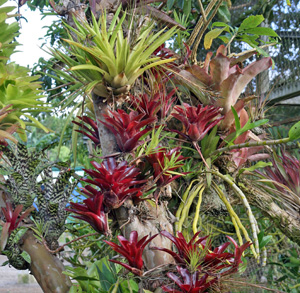
Bromeliads are a family of plants (Bromeliaceae, the pineapple family) native to tropical North and South America. Europeans first found out about bromeliads on Columbus’ second trip to the New World in 1493, where the pineapple (Ananas sp.) was being cultivated by the Carib tribe in the West Indies.
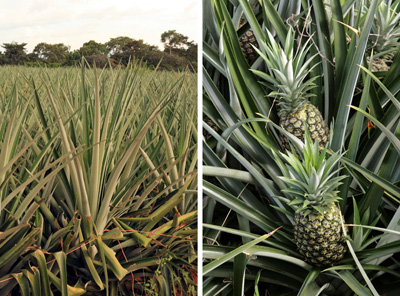
The commercial pineapple (Ananas comosus) is native to southern Brazil and Paraguay. After the colonization of the New World it was rapidly transported to all areas of the tropics, and now is widely grown in tropical and sub-tropical areas. The only bromeliad to occur north of the tropics is Spanish “moss” (Tillandsia usneoides). It is neither Spanish nor a moss but an epiphytic bromeliad. It doesn’t look much like a typical bromeliad, though, with its long scaly stems and reduced flowers.

Bromeliads are monocots, many of which, like their grass relatives, have a special form of photosynthesis that uses a variation of the more usual biochemical pathways to allow them to use water more efficiently. Even though they come from the tropics, this helps those that are epiphytes contend with life in the treetops where there is limited water and a real danger of drying out.

There are about 2500 species and several thousand hybrids and cultivars. Many have brightly colored leaves, flowers or fruit, and range in size from moss-like species of Tillandsia to the enormous Puya raimondii from the Andes which produces a flowering stem up to 15 feet tall. About half of these grow in the ground, while the remainder are
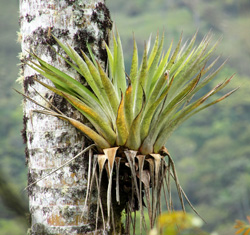
epiphytes, or air plants, that grow on trees or rocks. They cling to these supports with their roots but derive no nourishment from the trees. The small root system is used primarily for anchorage and the functions of water and nutrient uptake has been taken over by the leaves. Most bromeliads grow as a stemless rosette of leaves that may be symmetrical or twisted and curled.
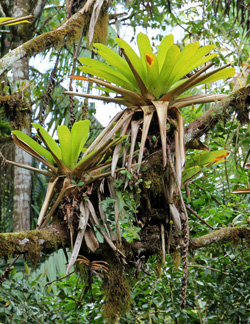
Tank bromeliads have leaves that form a reservoir to hold water at their bases, with the largest bromeliads holding up to two gallons of water. Types that don’t hold water are called xerophytic or atmospheric bromeliads.
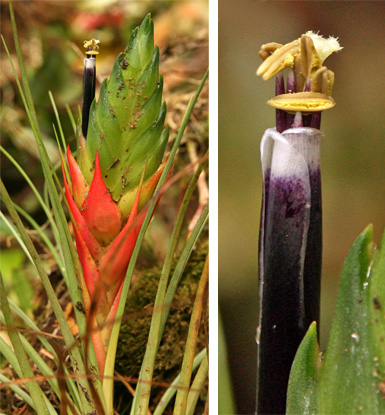
The flowers of most bromeliads are rather insignificant but the inflorescences can be quite spectacular with colorful bracts

(modified leaves at the base of several flowers) that last for several months. The true flowers, or florets, have three petals and 3 sepals surrounding six stamens and one stigma. The inflorescence may be an elongated spike, a panicle or raceme, or the flowers may occur in the center of the rosette, blooming one at a time over several months.
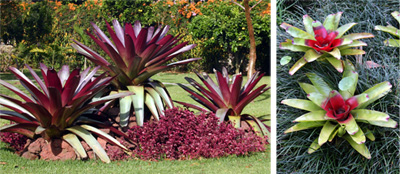
Bromeliads flourish in tropical and subtropical climates and are often used in these areas as bedding plants for outdoor ornamental plantings. Since no bromeliads will survive freezing, they can only be enjoyed as indoor plants in more temperate climates. If you do grow bromeliads as houseplants, they can be moved outdoors to enjoy natural rainfall and humidity during the warm summer months.
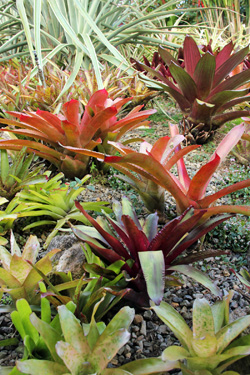
Types of Bromeliads
There are more than 50 genera of bromeliads, and many can be grown successfully as houseplants. The eight most commonly cultivated genera include the following.
The nearly 200 species of Aechmea are all tank epiphtyes. They have broadly bowl-shaped rosettes with arching leaves. The leathery, strap-like leaves may be solid, spotted, striped or banded but all have sharp teeth on the margins. The cylindrical, cone-like upright or pendant inflorescences have large, colorful bracts that remain in color for weeks or even months. They are often red, pink or orange, with blue, yellow or black flowers The flowers are often followed by fleshy, bright red or blue berries. Most are easy to grow, but need bright light.

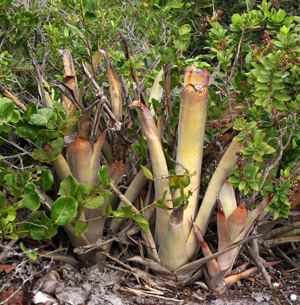
Billbergia is similar to Aechmea but its rosettes generally have only a few leaves that form a narrow tube or vase. There are about 60 species. The spine-edged leaves often have white or silver spots or banding, especially on the undersides. The inflorescences are mainly pendent and only last a couple of weeks, so they are grown primarily as foliage plants rather than flowering plants. The inflorescence is covered with pink, coral or red bracts and the flowers range from almost colorless to deep violet. A few are fragrant. They are easy to grow and are nice as hanging plants, since they often look best when viewed from below. Another attractive feature is that they tolerate dry air and can survive neglect better than most other plants.
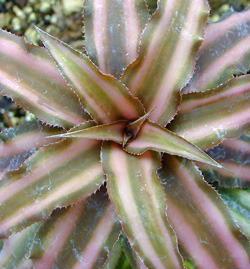
Cryptanthus is a terrestrial genus with nearly flat, star-shaped rosettes that do not hold water. This group of 50 species and several hundred hybrids is grown primarily for the foliage. The leaves are succulent, often have wavy and toothed margins, and are generally strongly banded or frosted with gray, white or bronze, often on a pink to red background color. Some popular cultivars have very elaborate banding with sharp zigzag patterns. Some have narrow, almost grassy, leaves. The genus name comes from cryptos + anthos meaning “hidden flower,” and in most cultivars the inconspicuous white, light green or pink flowers are nested low in the center of the rosette. They are moisture-loving, and are good for terrariums. Their popularity has spurred the formation of a separate Cryptanthus Society within the Bromeliad Society.
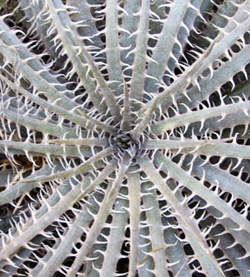
Dyckia is another terrestrial genus with 120 species whose rosettes do not hold water. The succulent leaves are very stiff and spiny. Some species have green leaves but most appear gray-green or white from the dense scale covering. Most species clump, forming large mats. Small, bright yellow or orange flowers are borne on unbranched spikes that emerge from between the leaves instead of from the center as with other bromeliads. The rosette does not die after flowering as it does in most bromeliad species. This genus needs very bright light and will tolerate months of drought, but need copious amounts of water during the growing season.
Most of the more than 150 species of Guzmania are tank bromeliads. The leaves are generally dark green (but a few are colored) and shiny with smooth margins. The fountain-like inflorescences have large, brightly colored bracts in yellow, green, purple, scarlet or red that last for months, and white or yellow flowers. These species come from shadier habitats than most other bromeliads, so will do well in lower light conditions. Many hybrids are well adapted to the home environment.

The 100 or so species of Neoregelia are all tank types. The rosettes are generally broad but some are vase-shaped. The leaves vary considerably among these species, and may be green, banded, striped, or spotted with various colors. The center leaves of many species turn bright pink, purple or red at maturity. Newer hybrids are frequently patterned in glowing pastels even when young. The leaf margins are normally serrated (but not spiny). The inconspicuous inflorescence barely rises above the water in the center of the plant, with small white, blue or lavender flowers, so these plants are grown primarily for their colorful foliage. These species develop the best color in strong light and with cool night temperatures.

Tillandsia is the largest group in the family, with considerable diversity among the 550 described epiphytic species. Most do not form tanks and have gray-green leaves. The smooth-margined leaves are densely covered with fuzzy scales that give the plants their characteristic color. Many species have strange growth form, with curling, twisted, or otherwise distorted leaves. Rosettes vary from very symmetrical to highly contorted. Inflorescences are quite variable also. They range from barely visible to long, multi-branched spikes. The spikes are often colorful, and the pink, red or lavender bracts enclosing the flowers are usually the showiest part. Some species have fragrant flowers. The duration of flowering varies considerably by species, from a couple of weeks to a full year. Tillandsias require more humidity than tank bromeliads and tend to dehydrate in the dry air of most homes, but can still be grown successfully with more frequent watering (misting is not adequate).

Vriesea is a group of about 250 species that are mostly tank epiphytes, with the rosettes forming broad vases. The smooth-margined leaves are either shiny green or patterned with scales or translucent windows. The spectacular inflorescences are most flattened, creating a sword-shaped appearance. The single or branched inflorescences are composed of brightly colored, overlapping bracts of brilliant red or yellow that last for months. Many are bicolored and numerous hybrids have been produced that are far superior in color and ease of culture than the wild species. They adapt to a wide range of conditions and generally make good houseplants.
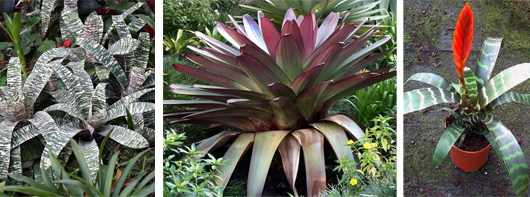
Bromeliad Culture as Houseplants
Bromeliads will survive for months or even years under less than ideal conditions. In order to thrive you need to provide your plant with satisfactory light, temperature, humidity and keep them appropriately watered, fertilized and potted.
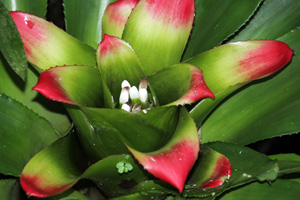
Light. Bromeliads should receive 12 to 16 hours daily of relatively bright light. Most species need 2000 footcandles but will have more compact growth and better leaf and inflorescence color at 3000-4000 footcandles. The different species vary in their requirements but the general rule is to give a plant as much light as it can tolerate without burning or bleaching. At these higher light levels the plants must also have higher humidity and more air circulation to prevent drying and burning. Plants need to be acclimated to brighter conditions gradually over a period of several weeks.
Bromeliads can also be grown under fluorescent lights. Lights should be hung about 8 inches above the tops of the plants.
Temperature. Most of the commonly grown bromeliads will tolerate a wide range of temperatures, some types can even handle nights near freezing and days over 100ºF. The optimal temperature range, though, is days of 70-90ºF and nights of 50-65ºF during most of the year. It is important that temperatures fluctuate by at least 10 degrees daily because most bromeliads have a special type of photosynthesis that requires substantial day-night temperature variations. Good air circulation is really only important at high temperatures to prevent sunburn. When the air is very dry, strong air movement may cause leaf tips to dry out and die.
Humidity. Bromeliads prefer relative humidity of 50 to 75% and need the higher levels as temperatures increase. But too high humidity seems to inhibit the formation of leaf scales, which may make some plants less attractive under these conditions.

Water. Most tap water is satisfactory for growing bromeliads but avoid alkaline or salty water. Do not use softened water — it contains lots of sodium (salt). Hard water can be used without affecting plant health. It will leave spots on the leaves, however, which can make plants unsightly, especially those with shiny green leaves. If you use water with a moderate mineral content, make sure you flush the centers of tank bromeliads every week to prevent the concentration of minerals that can cause leaf tip dieback. Bromeliads prefer water on the acid side (pH 4.0-7.0), but many can tolerate water up to at least pH 8.0. If you have water problems use deionized or rain water instead but be aware that very pure water can draw nutrients out of the leaves. Add a very small amount of fertilizer to distilled water to prevent this problem. Some types of bromeliads, particularly the miniature species, are very sensitive to salts, so distilled water should always be used for these.
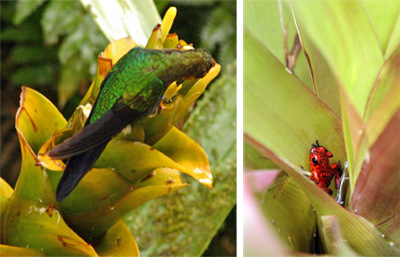
Fertilization. Bromeliads should be fertilized frequently with acidic, water-soluble fertilizer diluted to 1/4 to 1/8 strength. Drench the potting medium, foliage and central tank with the mixture. Slow-release fertilizer can also be added to the potting medium of some types. However, overfertilization will result in loss of color and can also produce overgrown rosettes with poor form.
Potting. There are numerous materials that can be used for potting bromeliads. Almost any potting mix that is acidic and holds moisture, yet drains quickly, is acceptable but do not put soil in the mix. The main function of the potting mix is to hold the plant steady, not to provide water and nutrients to the roots (except for terrestrial species). Roots quickly rot in a tight or saturated potting mix. Orchid bark mixed with coarse perlite and humus (Cymbidium orchid mix) is good for most bromeliads.

Choose the type of pot for your plants depending on your growing conditions. Porous clay pots dry out more quickly and therefore are more suitable for humid climates or if you tend to overwater. Conversely, plastic pots that retain moisture in the medium are better for use in dry climates (which includes indoors with air conditioning or forced air heating) or if you tend to not water regularly. Whatever type of pot you select should be of the appropriate size for the root system of the plant. A pot that is too large will remain wet, encouraging rot. Because most bromeliads have small root systems, a pot much smaller than would be used for other plants of the same size should be used. If the plant is too unstable in the appropriately-sized small pot, place the small pot inside of a larger pot for support rather than potting the plant in a larger container.
Many types of bromeliads can be mounted on pieces of decay-resistant wood or other nontoxic materials instead of being potted. Mounted plants require higher humidity and more frequent watering than potted plants and some benefit from a layer of moss in dry climates.
Propagation of Bromeliads
Most species of bromeliads produce offsets after flowering, with the original plant slowly dying after blooming. These offsets can be separated to create new single plants once they are about 1/3 the size of the mother plant. The exact method of removal depends on the species and its growth habit. The new plants should be potted appropriately and kept in a shadier, more humid site until new roots begin to grow. Keep the medium rather dry during this time to discourage rot.
– Susan Mahr, University of Wisconsin – Madison
Ask Your Gardening Question
If you’re unable to find the information you need, please submit your gardening question here:





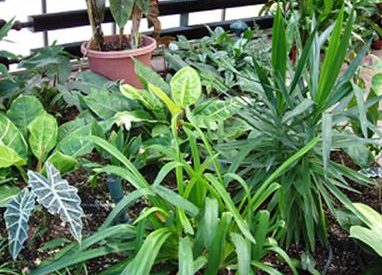 Houseplant Care
Houseplant Care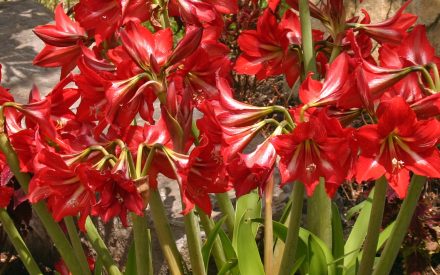 Maintaining Your Festive Houseplants
Maintaining Your Festive Houseplants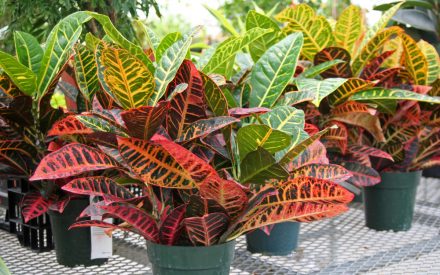 Bringing the Garden Inside
Bringing the Garden Inside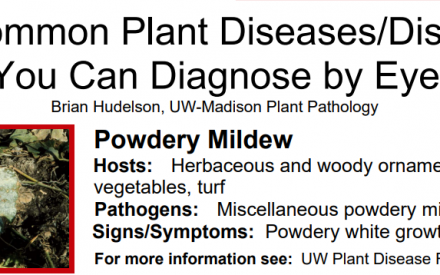 Ten Common Plant Diseases / Disorders You Can Diagnose by Eye
Ten Common Plant Diseases / Disorders You Can Diagnose by Eye


